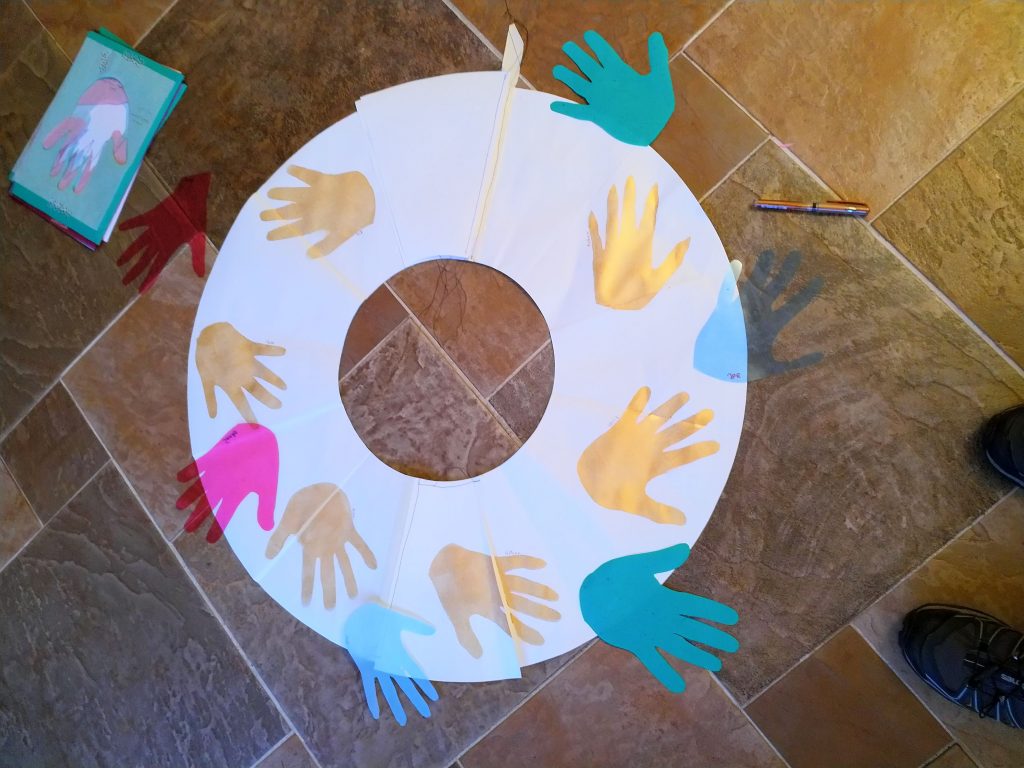#areyoubookenough_family

In 2019 I have decided to participate in the book-making challenge “Are You Book Enough” on Instagram.
The challenge was created by Sarah Mo, @inkandawl also known as @editions.studio on Instagram. Each month, a subject is selected to challenge bookbinders to create an artist’s book about the theme. February 2019: Family.
I knew immediately that I wished to create a circular book to symbolise the nature of family; evoking a concept of inclusion. In searching for ideas for structures, I discovered that it was more a doughnut shape, or toroidal structure, I was looking for. I found blogs by Elissa Campbell of “Blue Roof Designs” (http://www.blueroofdesigns.com Instagram: @blueroofdesigns) about a workshop held by an artist called Ken Leslie (http://www.kenleslie.net ), who had taught her his toroidal art book structure.
My idea for a toroidal structure was that I would use it to show images of my family’s handprints. When I thought about hands joined together in a circle, I thought that this looked exclusive, as if we did not allow others in. I thought that I would like to show the hands facing outwards to look as though we would welcome others to join. I also had to make decisions about how far to extend the invitation to family members – extended family or immediate? I made the decision to include only the living descendants of my father and mother, which also had the benefit of being limited to 12 people (a figure which would be significant when carving up the circle). The surface area had to be large enough to fit handprints, which meant I would have to deal with a fairly large circle. In the end, I settled on two semi-circles drawn on A1 paper, which was the largest I could find easily.

I started by creating semi-circles on a piece of lining paper (the type for wallpapering), which I had in the attic. I tried drawing with a pencil tied to a piece of string, but later discovered that the most accurate instrument I could create for drawing large circles was a piece of cardboard cut from a packing box, using a blunt pencil to anchor the centre and a sharp pencil poked through the card to draw the circumference.


Unfortunately the information about the toroidal book structure did not contain any clear instructions on how to create the folds, so I did some experimenting with a small shape and discovered that the folds worked best on my experimental structure if I kept two diagonally opposite sections of the circle whole and folded a centre line in each of the other 10 sections. In my initial trial I measured the sections by folding the circle into quarters, measuring the outside edge of the quarter with string and then dividing this into three to create 12 divisions. This structure looked good and folded up well. However, I decided that I did not want folds in the centre of each division as I was going to be spraying paint over masked areas and I did not want the segment to have a fold in it. The wallpaper was also not the quality of paper I wanted for my finished piece.

I then bought two sheets of A1 paper from Paperchase and created the largest possible semi-circle on each sheet. I joined them together using paper decorator’s tape. I later used my sewing machine to sew the tape to the paper so that it would be a more permanent join. If I were to do this again, I’d use a piece of ribbon sewn to the paper to give a more decorative and permanent flexible join.
To make 1/12th divisions, I watched a YouTube demo on how to create a dodecagon (https://www.youtube.com/watch?v=ahtDAvGKpeg), and found Wikipedia a useful source too (https://en.wikipedia.org/wiki/Dodecagon).
To create the content of my toroidal book, I wrote to all of the members of my family asking them to send me an outline drawing of their hand on A4 paper. When I received them, I copied the outlines onto a separate piece of paper (I used thin ‘deli’ paper at the time as I was thinking about making collage pieces). I then used this to cut plastic templates using A4-sized plastic folders or file dividers. I took care to keep both the cut out and the original piece so that I could make a stencil and a mask of the hand shapes.

I had recently watched the artist Antony Gormley’s BBC2 TV documentary “How Art Began” (https://www.bbc.co.uk/mediacentre/proginfo/2019/05/antony-gormley-how-art-began) in which he interviewed Michel Lorblanchet, a French expert on the subject of Palaeolithic art. Lorblanchet suggests that in the caves at Pech Merle in France, the handprints were created by a delicate “spitting technique”. I opted to use an old toothbrush, lollipop stick and diluted Quink blue ink to create the splatters for my handprints. One for each division of 12 on the inside of my book.


For the outside and covers, I used the remaining pieces from which the cut-outs had been made to create a decorative circular pattern of hands, alternating between Metallic Gold Acrylic paint and diluted Quink blue ink to create the pattern. I then over-stamped these with small leaf stamps using Ranger Archival ink in colours Cobalt and Coffee. This circular pattern covered 11/12 of the sections, with the remaining one having a cover affixed under which I secured a representation of the relationships between all participants on a descendant family tree from my parents to my children’s generation.

Tour of the Toroidal Book – outside
Tour of the Toroidal Book – inside
Toroidal Book – unfolding
Susan McNaughton, February 2019